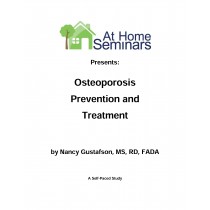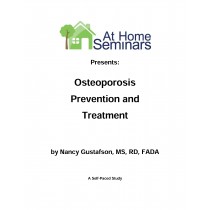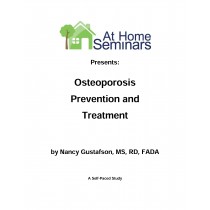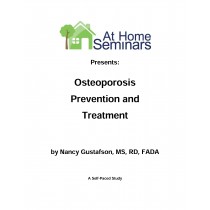
Osteoporosis Prevention and Treatment, 4th Ed
SKU: 510
By Nancy Gustafson, MS, RD, FADA
Up to one-third of women will be diagnosed with osteoporosis, with complications that are painful, disfiguring and debilitating. Surprisingly, men and younger women, particularly vegetarians, athletes and chronic dieters, are also at risk.
This course focuses on diagnostics, preventive and treatment modalities, as well as promising research developments. Includes case studies and appendices suitable for use as handouts.
Topics include: bone physiology; risk factors; preventive exercise, diet and supplementation regimes; diagnostic tests and techniques; hormone replacement therapy and much more.
Course Length: 10.0 contact hours
Instructional Level: Intermediate/Advanced
Osteoporosis Prevention and Treatment, 4th Ed
Course Goals and Objectives:
BEHAVIORAL OBJECTIVES
Upon successful completion of this course the student will be able to:
1. Identify the criteria for determining osteopenia and osteoporosis
2. Identify the reasons for osteoporosis prevention intervention
3. Identify the process of bone remodeling as it relates to bone accrual and bone loss throughout the life stages.
4. Identify the difference between trabecular and cortical bone and the relationship of each to fracture risk.
5. Identify the non-modifiable and modifiable risk factors for low bone density.
6. Identify why the incidence of osteoporosis is higher in women than in men, in some ethnic populations and for certain body types.
7. Identify the connection between hormonal status and osteoporosis.
8. Identify the implications of various types of physical activity/sports relative to bone density.
9. Identify an action plan for prevention of osteoporosis including reduction of risk factors, diet, physical activity, and possible prophylactic medications.
10. Identify dietary options to maximize bone health in special populations such as vegetarians, persons who are lactose-intolerant or who are unable to consume dairy products as a source of calcium.
11. Identify appropriate interventions for eating disordered individuals or women presenting with the “female athlete triad”.
12. Identify when bone density testing is appropriate, the options for testing currently available, and the rationale used for each type of test.
13. Identify the results of bone density tests and the implications for lifestyle changes.
14. Identify the current treatment modalities for osteoporosis, including diet, medications, and physical activity.
15. Identify alternative steps that can be taken to protect bone in postmenopausal women when hormone replacement therapy is not an option.
16. Identify the risk factors for fractures besides low bone density.
17. Identify the main components of an effective program of physical activity to prevent falls.
18. Identify the considerations for safe exercise in persons with established osteoporosis and comorbidities.
19. List environmental changes that can be made to reduce the risk of falls leading to fracture.
SKU: 510
By Nancy Gustafson, MS, RD, FADA
Up to one-third of women will be diagnosed with osteoporosis, with complications that are painful, disfiguring and debilitating. Surprisingly, men and younger women, particularly vegetarians, athletes and chronic dieters, are also at risk.
This course focuses on diagnostics, preventive and treatment modalities, as well as promising research developments. Includes case studies and appendices suitable for use as handouts.
Topics include: bone physiology; risk factors; preventive exercise, diet and supplementation regimes; diagnostic tests and techniques; hormone replacement therapy and much more.
Course Length: 10.0 contact hours
Instructional Level: Intermediate/Advanced
Osteoporosis Prevention and Treatment, 4th Ed
Course Goals and Objectives:
BEHAVIORAL OBJECTIVES
Upon successful completion of this course the student will be able to:
1. Identify the criteria for determining osteopenia and osteoporosis
2. Identify the reasons for osteoporosis prevention intervention
3. Identify the process of bone remodeling as it relates to bone accrual and bone loss throughout the life stages.
4. Identify the difference between trabecular and cortical bone and the relationship of each to fracture risk.
5. Identify the non-modifiable and modifiable risk factors for low bone density.
6. Identify why the incidence of osteoporosis is higher in women than in men, in some ethnic populations and for certain body types.
7. Identify the connection between hormonal status and osteoporosis.
8. Identify the implications of various types of physical activity/sports relative to bone density.
9. Identify an action plan for prevention of osteoporosis including reduction of risk factors, diet, physical activity, and possible prophylactic medications.
10. Identify dietary options to maximize bone health in special populations such as vegetarians, persons who are lactose-intolerant or who are unable to consume dairy products as a source of calcium.
11. Identify appropriate interventions for eating disordered individuals or women presenting with the “female athlete triad”.
12. Identify when bone density testing is appropriate, the options for testing currently available, and the rationale used for each type of test.
13. Identify the results of bone density tests and the implications for lifestyle changes.
14. Identify the current treatment modalities for osteoporosis, including diet, medications, and physical activity.
15. Identify alternative steps that can be taken to protect bone in postmenopausal women when hormone replacement therapy is not an option.
16. Identify the risk factors for fractures besides low bone density.
17. Identify the main components of an effective program of physical activity to prevent falls.
18. Identify the considerations for safe exercise in persons with established osteoporosis and comorbidities.
19. List environmental changes that can be made to reduce the risk of falls leading to fracture.





